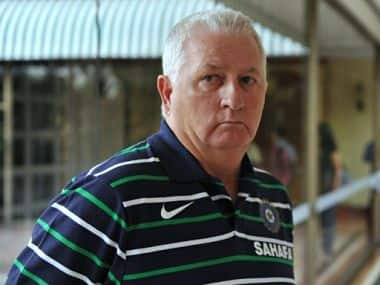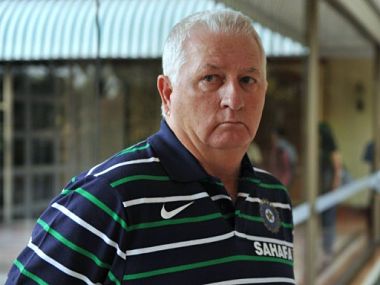By Chetan Narula in Manchester ‘Sir’ Geoffrey Boycott tells it like it is. After India’s humiliating collapse for 161 runs in the second innings of the fourth Test at Manchester, Boycott broke down the key factors for India’s consecutive losses. “Quite frankly, I do believe that England were so poor (at Lord’s) that they made India look better than they are,” he told BBC’s Test Match Special after the match ended in less than three days. “Because, if you think it through, their best batsmen, Virat Kohli hasn’t made a run on this tour and Cheteshwar Pujara, who’s their go-to-man at number three, he hasn’t made any runs either. And Bhuvneshwar Kumar, who was nipping the ball on the green-top at Lord’s, he looks as if he is absolutely knackered and is bowling slower and slower.” [caption id=“attachment_1658969” align=“alignleft” width=“380”]  File photo of India’s coach, Duncan Fletcher. AFP[/caption] The mask was lifted first when Ravindra Jadeja dropped Alastair Cook at Southampton. The English skipper was in such poor form than no one thought it would be a turning point. Less than a fortnight later, England lead the five-match series 2-1 and have absolutely decimated India in two successive Tests. There is not a shadow of doubt that this Indian team has been caught napping since Lord’s. The question to ask is this: What have Duncan Fletcher and his coaching staff been doing? Two days before the fourth Test, Fletcher was seen talking to Pujara and Kohli in the nets. If he is helping build the future of Indian cricket, then these two batsmen are its backbone. Fletcher knows it, and he also knew that they haven’t been scoring any runs. The two would bat in the nets, have a chat – twice for Pujara and longer than the one-time for Kohli – and then go back to working out. With four Tests gone, Pujara averages 25.87 in this series, Kohli 13.50. Clearly Fletcher’s tips haven’t worked. According to Dhoni, there is a simple explanation for this: “Duncan has the most technical knowledge. He has been helping Virat a lot and also other batsmen. These are people who have been playing for the last 12-13 years. It is tough to alter their basics in a few weeks or days. You may feel comfortable doing in the nets. But once you go into the middle, there is pressure on you and miss a few deliveries, the first thing you do is to go back to your basics. That’s your instinct. It will take a bit of time,” he said in the post-match conference. There is help available of course – even though it isn’t being useful – but the point here isn’t about whether Fletcher can iron out batsmen’s deficiencies. It is in how hands-on he is with his vast expertise in conditions that are very familiar to him. And the answer is not a lot. The Indian batsmen potentially needed to see out 61 overs on day three to save the match, given the weather forecast for days four and five. On Sunday, day four, it rained all day. The downpour had begun three hours after India collapsed. This should have been drilled into the batsmen. But watch the dismissals of Gautam Gambhir, Ajinkya Rahane and Dhoni again – needless shots all – and it is obvious that staying at the wicket wasn’t the goal. . This lack of awareness is perhaps most reflected in India’s slip fielding. The thinking process revealed by the management says that the team’s best fielders are placed in slips and hence they should make good slip catchers. It is a flawed concept. Fielding coach Trevor Penney was considered to be one of the best outfielders in the County circuit during his time. Does that automatically make him a good slip fielder? Nasser Hussain, who was England captain during the Fletcher’s stint with them, said on Sky that ‘Fletcher really works hard at slip fielding’. It can be seen when he personally gives practice to the slip cordon ahead of any match. It can also be noticed that they do not stand at particular distances from each other as they would in a match-situation, instead taking a rough out-of-position slip-cordon shape. Compare that to how England do their slip-catching practice – they do stand at proper measured distances from each other. It explains why so many catches fall short of first slip when India are bowling but carry to England’s fielders when the home side is bowling. Whenever Dhoni has not gone for a regulation keeper’s catch, the ball always falls short of first slip. “The first slip is standing at least one step too far behind,” Rahul Dravid said umpteen times on air for different broadcasters (BBC, Star and Sky). For four matches now, India has been making the same mistake. The third stand in this tripod, bowling coach Joe Dawes, bears some blame as well. This is not about line or length, or even field placements to tail-enders. This is about the simplest responsibility of a bowling coach and that is managing his resources. And Indian bowling resources have been mismanaged. Ishant Sharma is out injured, Kumar looked tired in Southampton and it showed in his lost pace at Old Trafford. From the onset of the series, the entire English team – be it their captain, coach, batsmen or bowlers – has spoken about the need to manage bowlers’ workloads. And they talked only about this series, not a whole season or even a calendar year. Meanwhile, this Indian team management’s careless attitude towards its bowlers is seen in Mohammad Shami’s absence from the fourth Test. “Some inconsistency has been creeping in Shami’s bowling, in his run-up and his action. It can be seen even in an over as also during a spell. His pace goes up and down,” said Dawes at Southampton. During that match, over-bowled, inconsistent with his pace, missing his line and length, Shami looked lost and for good reason. Ever since his debut last November, the Bengal medium-pacer has worked like a mule. He played all the matches against West Indies, all of them on tour in South Africa and New Zealand, and then all of them in the Asia Cup in Bangladesh. Staggeringly, he even played the dead rubber against Afghanistan in that tournament. Team management is obviously to blame for this. Dhoni talks about ‘process’ independent of ‘results’. The bottom-line however is this. Ironing out batting techniques, rebuilding an entire slip cordon from scratch and managing bowling resources takes time. If this team management had been in place only from the beginning of this tour, then it was understandable. Yet Fletcher and his coaching staff have been working since 2011. They have been here in England with India before. They have seen these same problems plaguing a different squad three years ago. And nothing has changed except the players’ names. If India lose a third consecutive Test to England, it should not matter that the World Cup is less than nine months away. Fletcher and his coaching staff would have already outstayed their welcome.
India have slumped to two humiliating defeats after beating England at Lord’s. India’s coach Duncan Fletcher, and his staff, have to take some of the blame.
Advertisement
End of Article
Written by FP Archives
see more


)

)
)
)
)
)
)
)
)



